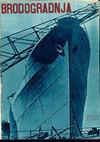Energy, exergy, economic and environmental analysis of a regasification system integrating simple ORC and LNG open power cycle in floating storage regasification units
IF 4.2
4区 工程技术
Q1 ENGINEERING, MARINE
引用次数: 0
Abstract
A thermodynamic, economic and environmental analysis of a regasification system including a simple Organic Rankine Cycle (ORC) and an Open Organic Rankine Cycle (OC) to utilise the liquefied natural gas (LNG) cold energy is carried out in the present paper. The proposed system, called ORC-OC, uses ambient seawater as heat source (open loop) and is implemented on board a Floating Storage Regasification Unit (FSRU) in order to reduce the greenhouse gas (GHG) emissions associated with the electricity generation plant, i.e., dual fuel (DF) engines. Regarding the ORC working fluids analysed, an ethane/propane zeotropic mixture is applied. The ORC-OC is compared with the simple ORC architecture, giving the first one better energy (lower specific energy consumption), exergy (higher exergy efficiency) and environmental (lower CO2e emissions) results. When compared to the regasification systems installed on board, the ORC-OC system reduces the specific energy consumption by 86.99 % and increases the exergy efficiency by 17.82 % with respect to the most efficient conventional system installed on FSRUs (direct seawater regasification system), leading to a reduction of CO2e emissions of more than 80 %. In addition, the ORC-OC system is more cost-effective than conventional regasification systems when the LNG price is above 6,508 USD/MMBtu.浮式储油再气化装置中集成简单ORC和LNG开放式动力循环的再气化系统的能量、火用、经济和环境分析
本文对利用液化天然气(LNG)冷能的再气化系统进行了热力学、经济和环境分析,该系统包括简单有机朗肯循环(ORC)和开放式有机兰肯循环(OC)。所提出的系统称为ORC-OC,使用环境海水作为热源(开环),并在浮式储存再气化装置(FSRU)上实施,以减少与发电厂(即双燃料(DF)发动机)相关的温室气体(GHG)排放。关于分析的ORC工作流体,应用了乙烷/丙烷共沸混合物。将ORC-OC与简单的ORC结构进行了比较,给出了第一种更好的能量(更低的比能耗)、火用(更高的火用效率)和环境(更低的二氧化碳排放)结果。与安装在船上的再气化系统相比,与安装在FSRU上的最高效的传统系统(直接海水再气化系统)相比,ORC-OC系统的比能耗降低了86.99%,火用效率提高了17.82%,从而使二氧化碳排放量减少了80%以上。此外,当液化天然气价格高于6508美元/MMBtu时,ORC-OC系统比传统再气化系统更具成本效益。
本文章由计算机程序翻译,如有差异,请以英文原文为准。
求助全文
约1分钟内获得全文
求助全文
来源期刊

Brodogradnja
ENGINEERING, MARINE-
CiteScore
4.30
自引率
38.90%
发文量
33
审稿时长
>12 weeks
期刊介绍:
The journal is devoted to multidisciplinary researches in the fields of theoretical and experimental naval architecture and oceanology as well as to challenging problems in shipbuilding as well shipping, offshore and related shipbuilding industries worldwide. The aim of the journal is to integrate technical interests in shipbuilding, ocean engineering, sea and ocean shipping, inland navigation and intermodal transportation as well as environmental issues, overall safety, objects for wind, marine and hydrokinetic renewable energy production and sustainable transportation development at seas, oceans and inland waterways in relations to shipbuilding and naval architecture. The journal focuses on hydrodynamics, structures, reliability, materials, construction, design, optimization, production engineering, building and organization of building, project management, repair and maintenance planning, information systems in shipyards, quality assurance as well as outfitting, powering, autonomous marine vehicles, power plants and equipment onboard. Brodogradnja publishes original scientific papers, review papers, preliminary communications and important professional papers relevant in engineering and technology.
 求助内容:
求助内容: 应助结果提醒方式:
应助结果提醒方式:


